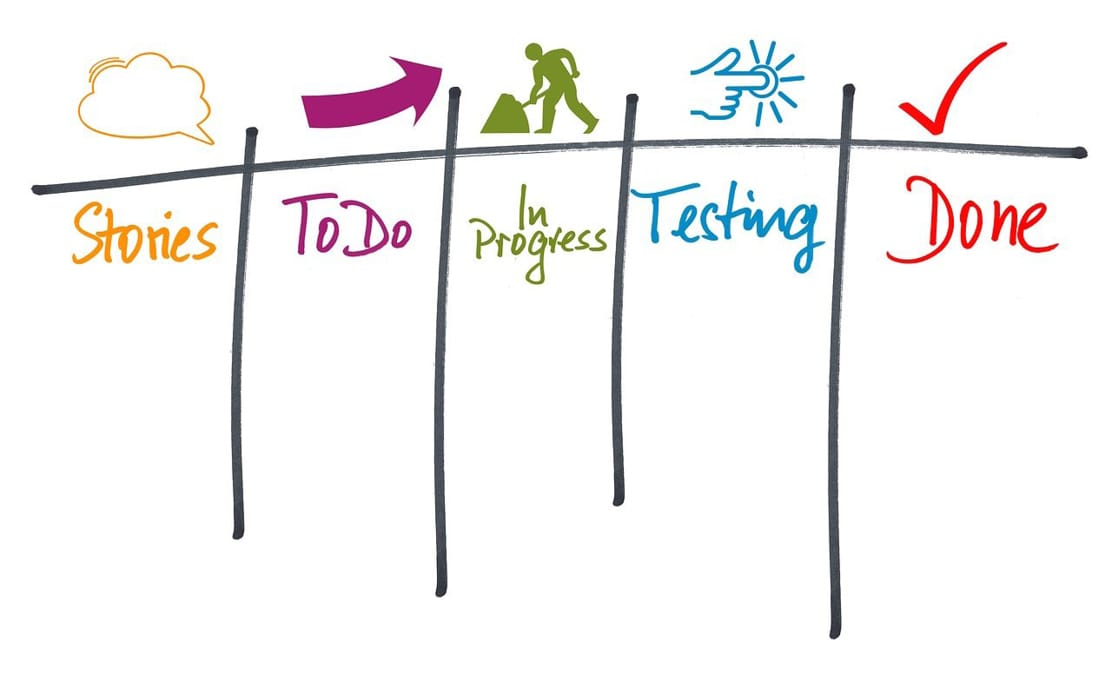KANBAN: VISUALIZE YOUR PRODUCTIVITY TO MANAGE IT

The Kanban method is a work management approach that originated in Japanese manufacturing and is now widely used in various fields, including software development. Known for its simplicity and flexibility, Kanban helps manage workflows effectively by focusing on visualization, continuous improvement, and limiting work in progress. The Kanban method is now part of the "Agile methods" and, along with Scrum, is one of the most well-known methodologies due to the visualization concept promoted by the Kanban Board, a principle adopted by the software provider Atlassian in its ticket management solution, Jira.
Origin
The term “Kanban” means “billboard” or “visual card” in Japanese. The Kanban method was developed by Taiichi Ohno in the 1940s at Toyota as part of the continuous improvement of its production system. The goal was to create a production management system that would reduce waste while improving efficiency and quality. Toyota's Kanban system used cards (kanbans) to signal production stages, indicate tasks to be performed, and track work progress. This system allowed Toyota to synchronize production with demand, producing only what was necessary, when it was needed. The concept was later adapted to other types of work, including software development.
Core Principles
The Kanban method is based on a few simple but powerful principles:
- Visualizing the Workflow: One of the basic principles of Kanban is visualizing the work. This is typically done using a Kanban board, where each task is represented by a card that moves through various columns representing different stages of the process (e.g., To Do, In Progress, Done). This visualization allows the entire team to see the current state of work and understand where bottlenecks are occurring.
- Limiting Work in Progress (WIP): The Kanban method imposes a limit on the number of tasks that can be in progress at the same time. This prevents team overload, improves focus, and helps maintain a smooth and continuous workflow. Limiting WIP also encourages completing ongoing tasks before starting new ones, reducing multitasking and improving efficiency.
- Managing the Flow: The Kanban method focuses on managing and optimizing the workflow to ensure fast and continuous delivery. By identifying and eliminating obstacles that slow down the flow, the team can improve the speed and quality of deliverables. In this method, we talk about a "pull flow" because it’s always the next step that triggers the advancement of cards on the board through the "WIP Limit," i.e., the number of cards in progress. Hence, the sizing and allocation of teams to different tasks becomes important.
- Continuous Improvement: The Kanban method encourages a culture of continuous improvement, where the team regularly analyzes its working process to identify opportunities for enhancement. This is often done during retrospective meetings, where the team discusses ways to optimize the workflow, reduce bottlenecks, and improve quality.
- Collaboration and Accountability: Kanban promotes collaboration among team members and shared accountability. Everyone is responsible for managing their work and the overall progress of the project, fostering strong team spirit and open communication.
Application in Software Development
Although Kanban was originally designed for manufacturing, it has been successfully adapted to software development and project management. In software development, Kanban is often used to manage tasks related to maintenance, technical support, bug fixes, and continuous product improvement.

A typical Kanban board for software development might include the following columns:
- Backlog/Stories: A collection of tasks or features to be completed.
- To Do: Tasks ready to be taken up by the development team.
- In Progress: Tasks currently being worked on.
- To Test: Completed tasks that are now ready to be tested by a dedicated team.
- Done: Completed tasks ready to be delivered or already delivered.
Kanban is often used in an Agile environment, either on its own or in combination with other methodologies like Scrum. For example, some teams use a Kanban board to manage daily tasks while following a Scrum sprint cycle. This hybrid approach, often called Scrumban, takes advantage of both Scrum and Kanban methods.
Advantages
The application of Kanban in software development and other sectors presents many benefits:
- Simplicity and Ease of Implementation: Kanban is easy to understand and implement. It doesn't require a major overhaul of the existing team or work processes. Teams can start using Kanban with minimal effort and adjust the system over time.
- Flexibility and Adaptability: Unlike more structured methodologies, Kanban does not impose fixed work cycles or predefined roles. This flexibility allows teams to quickly adapt to changing priorities and adjust according to project needs.
- Clarity in Work Visualization: Visualizing work through a Kanban board provides complete transparency about the progress of the project. This helps teams identify bottlenecks and manage priorities more effectively.
- Reduced Multitasking: By limiting work in progress (WIP), Kanban helps reduce multitasking, which improves team members' focus and allows them to complete tasks more quickly.
- Improved Workflow: Kanban focuses on optimizing the workflow, leading to faster delivery of features and better customer satisfaction.
- Continuous Improvement: Kanban integrates a continuous improvement process, allowing teams to regularly analyze their performance and make adjustments to enhance efficiency and product quality.
Conclusion
Since its application in the Japanese automotive industry, the Kanban method has evolved into a valuable tool in software development and modern project management. Its simplicity, flexibility, and focus on visualization and continuous improvement make it an ideal method for teams looking to optimize their workflows and quickly adapt to changes. Whether managing daily tasks, developing software, or managing complex projects, Kanban offers an adaptable and effective framework to achieve success. Kanban often represents a great way to gradually transition to agility.
